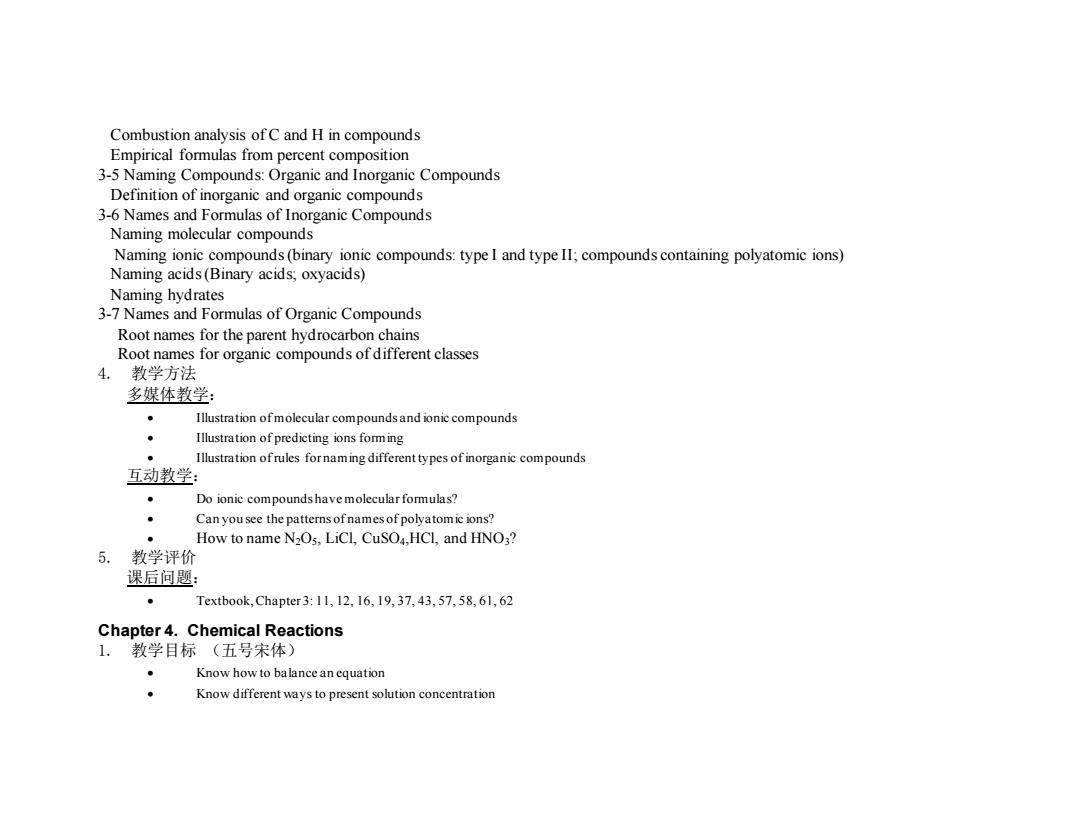正在加载图片...

Combustion analysis of C and H in compounds Empirical formulas from percent composition 3-5 Naming Compounds:Organic and Inorganic Compounds Definition of inorganic and organic compounds 3-6 Names and Formulas of Inorganic Compounds Naming molecular compounds Naming ionic compounds(binary ionic compounds:type I and type II;compounds containing polyatomic ions) Naming acids(Binary acids;oxyacids) Naming hydrates 3-7 Names and Formulas of Organic Compounds Root names for the parent hydrocarbon chains Root names for organic compounds of different classes 4.教学方法 多媒体教学: Illustration ofmolecular compounds and ionic compounds Illustration of predicting ions forming ● Illustration ofrules fornaming different types of inorganic compounds 互动教学 Do ionic compounds have molecular formulas? Can you see the patterns ofnames of polyatomic ions? How to name N2Os,LiCl,CuSO4,HCL,and HNO3? 5.教学评价 课后问题: Textbook,Chapter.3:11,12,16,19,37,43,57,58,61,62 Chapter 4.Chemical Reactions 1.教学目标(五号宋体) Know how to balance an equation Know different ways to present solution concentrationCombustion analysis of C and H in compounds Empirical formulas from percent composition 3-5 Naming Compounds: Organic and Inorganic Compounds Definition of inorganic and organic compounds 3-6 Names and Formulas of Inorganic Compounds Naming molecular compounds Naming ionic compounds (binary ionic compounds: type I and type II; compounds containing polyatomic ions) Naming acids (Binary acids; oxyacids) Naming hydrates 3-7 Names and Formulas of Organic Compounds Root names for the parent hydrocarbon chains Root names for organic compounds of different classes 4. 教学方法 多媒体教学: • Illustration of molecular compounds and ionic compounds • Illustration of predicting ions forming • Illustration of rules for naming different types of inorganic compounds 互动教学: • Do ionic compounds have molecular formulas? • Can you see the patterns of names of polyatomic ions? • How to name N2O5, LiCl, CuSO4,HCl, and HNO3? 5. 教学评价 课后问题: • Textbook, Chapter 3: 11, 12, 16, 19, 37, 43, 57, 58, 61, 62 Chapter 4. Chemical Reactions 1. 教学目标 (五号宋体) • Know how to balance an equation • Know different ways to present solution concentration